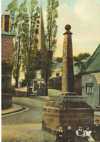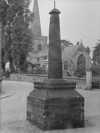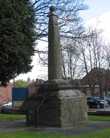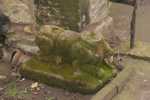For this church:    |
| ||||||
The other famous grave, which presumably was dismantled at the time of the levelling of the grave yard, was that of Captain William Sleigh. Captain Sleigh died on the 20th April 1842 aged 62. Fellows, visiting in 1906, describes the tomb as being surrounded by iron palisades. It was close to the church door and over it was a sarcophagus shaped monument. It was guarded by four small sphinxes, three of which still do duty outside the church porch today. The stone containing the inscription had already shaled off in 1906 but sufficient was left to show that it described his service with the British Army in the early nineteenth century.
 |
 |
 The Anglo-saxon The Anglo-saxoncross in 2011 |
The cross as it has been |
||
The Anglo-Saxon Cross
The old cross has been in and out of the churchyard over the years but at present it stands inside overlooking Church Street. Generally regarded as one of the most important objects in the county its origin and history have been the subject of much speculation over the years. This is not the place to go into much detail, that can be found elsewhere, except, perhaps, to draw attention to the latest thinking on the subject by Phil Sidebottom of the University of Sheffield. In his article in British Archaeology April 1997 he describes his researches into north Midlands stone sculpture and concludes that the crosses were erected to acknowledge the submission of the Danish North after 920 to the West Saxons and the Roman Church, who were then operating in partnership. The crosses appear to have been erected at the centres of the old estates, most of them in churchyards (where they can still be found today), as though accepting the authority of the Church as well as the West Saxon king. In private correspondence he concluded that the Stapleford cross shaft could be identified with a large group of crosses which were synonymous with the Mercian Vikings, ie that group which settled in the area after 870, and would date it to c920AD. He thinks it likely that the church was already there when the cross was erected.
The cross has its own listing description.







